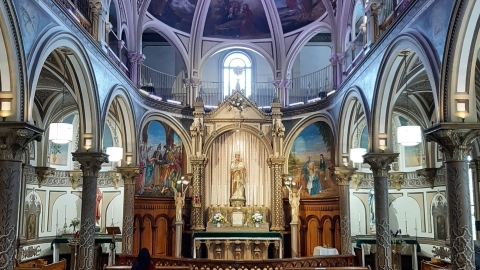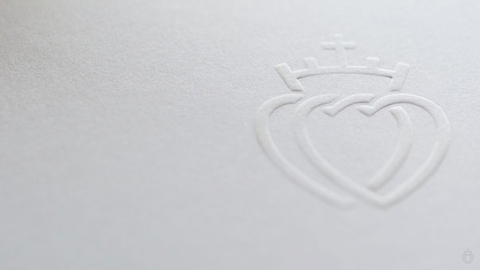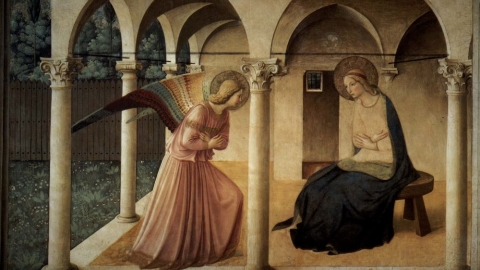50 Years of the New Mass: Joseph Andreas Jungmann (18)

Josef Andreas Jungmann
The Liturgical Movement, begun under the best auspices, first wanted to restore the liturgy somewhat abused by the passing centuries, but also to respond to the secularization at work in European society since Luther’s Reformation and the French Revolution .
To reach their end, Dom Guéranger, as well as St. Pius X, sought to show the abyss that separates the modern, self-proclaimed profane world, from the sacred world of grace, the Church, and her liturgy. The latter is an important means of resisting this new society which is being built without God, or even in opposition to Him.
Another Direction
But the Liturgical Movement, from the 1930s, and especially after the Second World War, took another option: trying to reduce the distance between the sacred and the profane, especially in the means of performing liturgical acts, or even by modifying the rites themselves.
Proponents of this second option argued that liturgical reforms had always existed. But, in perspective, it was a serious error, a real anachronism. Because all the ancient variations in the liturgy were factual, the fruit of a natural and organic development. In our modern liturgies, it is a desire for reform wanted for sake of reform, in a rational and systematic manner.
This intention is based on an ecclesiological movement—represented by Fr. Yves Congar, for example—which wants to rethink the structure of the Church from an ecumenical perspective. The goal is to make the Middle Ages parenthetical, to rediscover the theology of the [early] Fathers. This made it possible to take out of context the medieval scholastic vocabulary which was consecrated by the Council of Trent.
As for the ancient liturgy, as the neo-liturgists imagined or thought about it, it seemed favorable to an ecumenical reconciliation. There again, the post-Tridentine books were accused of having misunderstood the true nature of the liturgy. This was to give a consistency to Luther’s criticisms.
Finally, the Liturgical Movement thought that it could rediscover “pure” liturgical forms, more understandable and easier to access for modern man living in a desacralized and secularized society. With this in mind, Latin was one of the first victims offered up to the condemnation of members of the Movement. Latin gathered together in itself all that they abhorred, especially as it stood as an obstacle to the expected aggiornamento.
The Working Axis of the Movement
In order to try to give easier access to divine worship, under the leadership of Dom Lambert Beauduin, the Movement set for itself the task of helping the faithful better understand the liturgical ceremonies, and allowing them to participate better in them. Two means were used to achieve this goal.
For the neo-liturgists, the only people who had really understood the liturgy were the early Christians. As a model for their restoration, they went back to the liturgy as practiced in Rome around the 5th century. It then became a matter of ridding the missals of the different strata accumulated over the centuries, especially by the much-maligned Middle Ages. Among those who distinguished themselves in this enterprise, Fr. Jungmann stands out.
Joseph Andreas Jungmann was born on November 16, 1889 in Tubre, in the province of Bolzano, currently in Italy, but which was a part of Austria until 1918. Fr. Jungmann was therefore of Austrian nationality.
He entered the minor seminary of Bressanone in 1901 and then the major diocesan seminary in 1909. He was ordained a priest on July 27, 1913 in Innsbruck. He was first curate for two years in Niedervintl and then in Gossensass. He entered the Jesuit novitiate in September 1917, in St Andrä, in the Austrian province of Carinthia.
In 1918, he was admitted to the Jesuit theological school in Innsbruck where he received a doctorate in 1923. He became interested in the liturgy and wrote several works on this field. He frequently communicated with the main actors of the Liturgical Movement in Germany, and became a member of the liturgy commission of the German episcopate in 1939, under the direction of Msgr. Simon Landesdorfer, bishop of Passau, along with Romano Guardini.
Jungmann believed that there must be a return to the liturgy as it was practiced in Rome between the 4th and 6th centuries, in particular under the popes St. Damasus (366-384), St. Leo the Great (440-461), and St. Gregory the Great (590-604). It would therefore be necessary to rediscover these rites and ceremonies, idealized as the most “pure,” as if they had been hidden or debased by additions, in particular those that occurred in Gaul from the 8th century, which were then taken up by Rome around the 10th century.
The main study devoted by Jungmann to this effort is his famous treatise Missarum Sollemnia, published in 1948. He strives to show that the Roman Rite underwent frequent changes, which implies that they should be allowed to carry out such a thing today, including in the opposite direction.
Here is how Fr. Jungmann explains the degradation of the liturgy by men of the Middle Ages: “The liturgy, celebrated in a lively way, for centuries had been the main form of pastoral care. This is true first of all, for the earliest time when the liturgy was created in its essential forms. However, due to unfortunate circumstances, it happened that in the late Middle Ages many collegiate and monastic churches no doubt celebrated the liturgy with great zeal and brilliance, and even enriched it with new forms: but at the same time something intervened between the liturgy and the people like a wall of mist, through which the faithful could only see in a confused way what was happening at the altar…”
“The word of the liturgy, which is first to raise souls to God, had become inaccessible to the people. Of the prayers and songs which make up the sacred action, only sound touches the ears. The liturgy becomes a series of mysterious words and ceremonies, the unfolding of which is fixed by precise rules, which one strives to follow with holy respect, but which ultimately freeze them as well.”
Studies were working on learned reconstructions. Thus, Dom Henri Leclercq (1869-1945), theologian and historian, author of a very beautiful history of the martyrs, published a gloss of the Ordo romanus primus—first Order or Roman Missal, dating from the 7th century—which provided a canvas upon which to imagine a restitution of these ceremonies. It would be taken up by the innovators with enthusiasm.
Active Participation
The search for more active participation by the faithful is undoubtedly the main characteristic of the Liturgical Movement. The innovators wanted to abolish the read [or low] mass, or at least prevent the faithful from attending it—at that time, only the server answered aloud to the priest, as is still done in Anglo-Saxon or Germanic countries. They considered it absurd that the faithful could assist mass by praying the rosary, or by devoting themselves to pious readings. This is why they also wanted to remove the rood screens which stood between the nave and the choir, or even to turn the altar towards the people.
Behind this desire for active participation is a distorted theology of the priesthood, as has already been said: the assimilation of the presbyteral priesthood to the common priesthood of the faithful, a theme that will be encountered at the Second Vatican Council.
Fr. Jungmann has his ideas about this active participation. It manifests itself in two aspects. The first is not specific to him, it had already been encountered in the writings of Romano Guardini and Pius Parsch, his friends: the Mass is a meal. He writes, “But the sacrifice of the New Covenant is essentially constituted as a meal, so that the offerors might gather around the sacrificial table, the table of the Lord, to eat…A table is set, it is the table of the Lord… the meal is still in our own time the basic form of the eucharistic celebration.”
The second aspect is personal to him. Jungmann points out that mass is a service of praise and thanksgiving, performed by the whole community. He attributed this mode of worship to the early Christians and believed that it disappeared when the ordained priesthood reserved the mass for itself. Thus, according to him: “The corporate character of public worship, so significant for primitive Christianity, began to crumble at the base.”
Consequently, he mentions the “concelebration of the laity” as a desirable element that the Church should restore. At a liturgical congress in Munich, in 1955, he called for a new understanding of the Mass, for a “revival of the meaning of the Mass as an authentic community offering,” on the grounds that “over time we have lost the meaning of the liturgy.”
The influence of Josef Jungmann was very important, especially since unlike the other initiators, he was able to take an active part in the preparation for the Second Vatican Council as a member of the preparatory commission for the liturgy beginning in 1960. He became a member of the commission for conciliar liturgy in 1962, and was finally consultant of the Consilium, the organ charged by Paul VI to carry out the conciliar reforms. He died on January 26, 1975.
He was therefore one of the main architects of the New Mass and of the relegation of the Tridentine missal, and of the pastoral and liturgical disaster that followed.
(Sources : Barthe/Wikipedia - FSSPX.Actualités - 28/03/2020)



